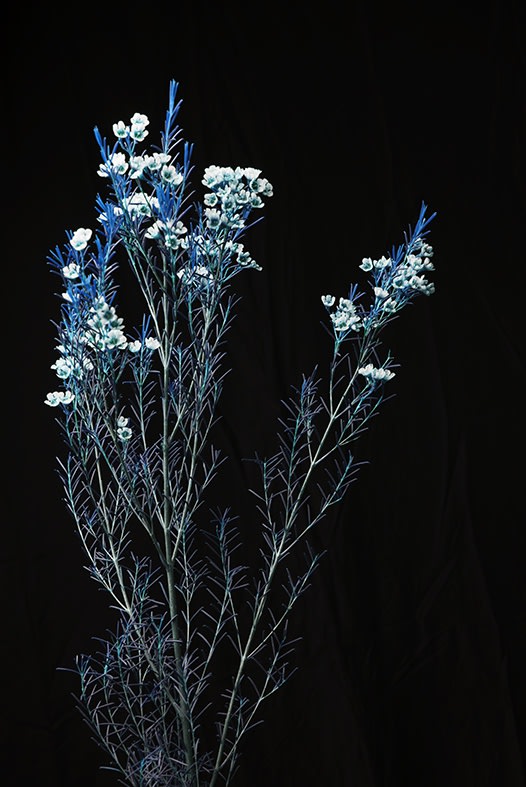Tanja Lažetić
For English version please scroll down.
O SERIJI
Rada opazujem odpiranje popkov. Čakam tisti poseben trenutek, ko je cvet popolnoma odprt. Takrat jih fotografiram. Umetne so, čeprav rastejo in se razvijajo, zato iščem pravo barvo tega kar vidim. Tudi popke fotografiram, ampak ne sušenja in gnitja, ker okrasne rože niso bile narejene zato, da bi se postarale. – T. L.
V umetnostni zgodovini skorajda ne poznamo motiva, ki bi bil tolikokrat in na toliko načinov upodobljen, interpretiran in diskutiran, kot cvetje. Rože so nosilke najrazličnejših simbolov in pomenov, katerih razpon sega vse od antičnih mitov Narcisa in Dafne, krščanskih interpretacij rož kot simbolov kreposti in svetopisemskih zgodb, ter romantične literature 19. stoletja in intenzivnih asociacij z ljubeznijo in lepoto. Zaradi svoje zgodovinske vloge v umetnosti so rože tako močen semiotični znak, upodobitev cvetja pa je tako nasičena s kulturnozgodovinskimi pomeni, da se ob pogledu na njihovo podobo nevtralnost popolnoma izmakne in naša percepcija upodobljenega je hote ali nehote prežeta z asociativnimi pomeni. Tega se umetnica Tanja Lažetić dobro zaveda, zato v svojo serijo fotografij 5 rož 8 fotografij vpelje sodobne problematike, preigrava pretekle konotacije cvetja in jih umešča v čas sodobnosti.
Eden od aspektov rož, ki umetnike navdihuje skozi stoletja, je njihova zmožnost neposrednega simboličnega prikaza cikla človeškega življenja – poosebljajo lepoto mladosti v polnem cvetu, venenje srednjih let in končno neizbežno smrt. Cvetje je s koncem življenja povezano že z antičnimi miti, najbolj očitno reprezentiranimi z rožami, ki zrastejo iz prelite krvi ali groba umrlega, simbolično naznanjajoč nov začetek ali življenje, ki vzcveti iz smrti. Rezano cvetje kot znanilec ničevosti in minljivosti življenja se najbolj izrazito pojavi v slikarstvu 17. stoletja, ki rože povezuje z motivom vanitas – simbolična upodobitev kratkosti življenja in minljivosti, memento mori, ki nas opozarja na neizbežni konec. Vazno cvetje je v tem kontekstu jasno prepoznaven simbol, saj se mu čas začne iztekati s samim dejanjem utrganja. Umetniki kot je Jan Brueghel so motiv v slikarstvu pripeljali do vrhunca, odražal pa je širšo mentaliteto zahodne katoliške družbe, ki je zemeljsko življenje dojemala kot obdobje moralnega preizkusa pred vstopom duše v posmrtni raj (ali pogubo).
A zahodna družba je danes po svoji percepciji duhovnega in stvarnega sveta popolnoma drugačna od baročnega katolicizma 17. stoletja, dejstvo, ki ga Lažetić v svojem delu jasno izpostavi. Motiv vanitas v opisanem pomenu besede sicer ostaja prisoten v sodobni umetnosti – v fotografiji so počasno odpadanje cvetov in trohnenje cvetlic interpretirali fotografi kot sta Jan Saudek in Michael Wesely. Vendar iskanje lepote v minljivosti in smrti ter svojevrstna poetika trohnečih cvetov umetnice ne prepričata. Rože predstavi ravno nasprotno, kot sijoče, skoraj plastične objekte, katerih propad še zdaleč ni na obzorju. V nasprotju z baročno percepcijo iztekanja življenja so rože Tanje Lažetić odraz družbe, ki se s smrtjo in minljivostjo ne želi, morda celo ne more spoprijemati. Mladost, obstojnost in vizualna izpopolnjenost so vrline najvišje vrednosti, šibkost, bolezen in ostarelost pa prestrašeno zavračamo, na kar opozarjajo vedno bolj obupani poskusi podaljševanja človeškega življenja. Zato so njene rože prirejene, popravljene, »izboljšane« do perfekcije večnega življenja, z digitalno modifikacijo pa iz cvetlic izvabi njihove »prave« barve.
V želji po lepših in obstojnejših cvetlicah jih uvažamo iz tujine, brez ozira na njihovo poreklo. Rože umetnica vidi kot umeten konstrukt, saj sam koncept okrasnih rož vedno manj povezujemo z nabiranjem v naravi ali sajenjem doma. Večino okrasnega cvetja, ki je na voljo v prodajalnah, je uvoženega iz tujine, preko Nizozemske pripeljanega v domače cvetličarne. Lažetić problematizira tovrstne prakse in v tem smislu idejno nadaljuje svoj projekt Migranti, leta 2010 razstavljen v galeriji P74. V projektu raziskuje vprašljivo poreklo naše vsakodnevne hrane, ter opozarja na zaskrbljujoče učinke internacionalnega uvoza. Čeprav je ta aspekt projekta manj izražen pri njenih rožah pa dodatno demonstrira njihov umetni, nenaravni značaj, predvsem pa premišljen odnos umetnice do fotografiranih objektov.
Lepe in dišeče so na svetu zato, da pomagajo pri razmnoževanju rastlin. Majhne cvetove lahko opraši veter, večje rože pa morajo biti prijetnih oblik, privlačnih barv in predvsem vabljivega vonja, privabiti morajo žuželke, ptice, včasih celo netopirje, ki bodo hodili po njih, v njih vtikali svoje kljunčke, nabirali cvetni prah, pili nektar in tako prenašali pelod s cveta na cvet. – T. L.
Popolnost in lepota, ki sta pričakovani od rezanega cvetja, jasno aludirata na širšo motnjo družbe, ki tovrstne kvalitete zahteva od ljudi – in najbolj očitno od žensk. Povezava rož z ženskami je skoraj samoumevna, vzpostavlja pa se na dveh nivojih. Iz socio-zgodovinskega vidika so bile rože od nekdaj v domeni ženskih umetnic, ki vse do 20. stoletja povečini niso imele dostopa do slikarskih akademij, urjenja v slikanju aktov in veliko-formatnih historičnih kompozicij, pač pa so bile omejene na slikanje tihožitnih šopkov in okolja domačega vrta. Obenem se povezava vzpostavi na ikonografski ravni, saj so bili ženski liki pogosto personificirani z rožami in slednje že od antike povezane s feminilnostjo – nimfa Kloris, ki se z Zefirjevim posilstvom preobrazi v Floro, Dafne, ki se v begu pred Apolonom spremeni v lovor, kasneje pa Marija, ki je velikokrat upodobljena kot vrtnica ali lilija. Rože si z ženskami namreč delijo dve ključni funkciji – predstavljajo ljubezen, lepoto, mladost in nudijo estetski užitek, zaradi svoje vloge oprašenk pa imajo jasno reproduktivno funkcijo s konotacijami erotičnosti in zapeljevanja. Tako Lažetić raziskuje motiv cvetja v relaciji do lastne pozicije umetnice, in se obenem sprašuje o samem načinu upodobitve.
5 rož 8 fotografij je projekt, ki preigrava vprašanja trajnosti, umrljivosti in družbenih pričakovanj. Umetnica odnos med mladostjo, vizualno perfekcijo in umetnim zrcali v svojih rožah. So popolne, žareče, eksotične – namišljene. Takšne rože (in takšni ljudje) ne obstajajo drugje kot v naši domišljiji. Vprašanja, ki jih Tanja Lažetić odpira, so sledeča: bi morale biti rože privlačne, popolne, umetne? Bi takšne morale biti me? In kakšna je cena popolnosti?
Hana Čeferin
ABOUT THE SERIES
I like watching the opening of flower buds. I wait for that special moment when the flower is fully blossomed. They’re artificial, even though they grow and age, which is why I search for the true colors of what I see. I photograph buds, too, but not wilting and rotting, because decorative flowers were not made to grow old. – T. L.
Hardly any motif in the field of art history has been depicted, discussed and interpreted as often and in so many ways as a flower. It is the carrier of such a wide array of symbols and meanings – their interpretations range from classical myths of Narcissus and Daphne, to Christian interpretations of flowers as symbols of virtues and biblical tales, to Romantic literature of the 19th century, which intensely associated flowers with love and beauty. Because of their historic role in art, flowers are such a powerful semiotic sign, their depictions so drenched in socio-historic meanings, that the notion of a neutral gaze is completely unimaginable. Out perception is consciously or subconsciously saturated with associative meanings. The artist Tanja Lažetić is aware of this, questioning past connotations of flowers in her photography and placing them firmly in the sphere of contemporaneity.
An aspect of flowers that has been inspiring artists throughout the centuries, is their ability to symbolically depict the cycle of human life – they embody the beauty of youth in full bloom, the wilting of middle age and finally, the inevitability of death. Flowers are associated with dying since the classical age, which introduced myths of flowers blossoming from spilt blood or graves of the deceased, symbolically marking a new beginning or life blossoming out of death. Cut flowers as symbols of the transience and futility of life are most clearly observed in 17th century painting, where they are closely connected to the vanitas motif – the symbolic depiction of life’s fleeting and trivial nature, memento mori, which reminds us of the inescapable end. From this perspective, a bouquet of cut flowers, whose lifespan is cut short through the very act of plucking, is a clearly recognizable symbol of life’s evanescence. The motif, which artists such as Jan Brueghel brought to its peak, reflected the wider mentality of Western Catholic population, which perceived earthly life as a moral trial period before a soul transcends into paradise (or damnation).
However, the perceptions of the spiritual and physical world in today’s Western society are entirely unlike those of baroque Catholicism of the 17th century, a fact Lažetić clearly emphasizes. Assuredly, the vanitas motif, in the previously described sense of the word, still remains present in contemporary art. In photography, the slow falling of petals and wilting of flowers was interpreted by Jan Saudek and Michael Wesely. In contrast, Tanja Lažetić does not seek inspiration in the beauty of transience and death and the particular aesthetic of decaying plants. She presents her flowers as quite the opposite, as shiny, almost plastic objects, whose decay is far from sight. In contrast with baroque’s perception of life coming to an end, Lažetić’s flowers reflect a society which does not want to, perhaps cannot, deal with death and mortality. Youth, vitality and visual perfection are virtues of the highest value, while weakness, disease and old-age are regarded with fear and rejection, a fact proved by the ever more desperate attempts at prolonging human life. That is why her flowers are modified, perfected, “improved” towards the perfection of eternal life. Through digital modification, the artist finds their “true” colors.
In our desire to own prettier, longer-lasting flowers, they are imported from abroad with little regard to their origin. The artist considers flowers to be an artificial construct, since the very notion of decorative flowers is becoming less connected to nature or at-home gardening. Most flowers that are available in shops are imported from abroad, brought to our local flower shops through the Netherlands. Lažetić questions these practices and in that sense conceptually continues her project Migrants, exhibited in Gallery P74 in 2010. In the project, she has researched the questionable origins of our everyday groceries, warning us of the potential dangers of international import. Although this aspect of the project is less emphasized in her flowers, it additionally demonstrates their artificial, unnatural character, while also speaking about the prudent approach of the artist to her photographed subjects.
Beautiful and fragrant, they are in this world to help reproduce plants. Wind can pollinate smaller petals, but larger flowers need to be pleasantly shaped, of attractive colors and most importantly, smell inviting. They need to attract insects, birds, sometimes even bats, who will walk over them, insert their beaks in them, collect pollen, drink nectar, and spread it from blossom to blossom. – T. L.
Perfection and beauty expected from decorative flowers clearly allude to a more widely prevalent problem – a society which seeks these qualities in people, and most obviously in women. The connection of flowers to women is practically self-evident and establishes itself on two levels. From the socio-historic perspective, flowers always belonged in the domain of female artists, since women were prevented from attending art academies, training in the painting of the nude and, consequently, producing large-format historic compositions. They were limited to painting still-life bouquets and the confines of their home garden. Furthermore, a connection is established on the level of iconography, as women figures were frequently personified by flowers, the latter connected to femininity since antiquity – the nymph Chlorys who transforms into Flora through Zephyr’s rape, Daphne, who morphs into a laurel tree during her flight from Apollo, and later Mary, often depicted as a rose or a lily. Flowers, it seems, share two crucial common characteristics with women – they represent love, beauty, youth and offer aesthetic pleasure upon sight. Simultaneously, they have a clear reproductive function with connotations of eroticism and seduction, due to their role in pollination. Thus, Tanja Lažetić is investigating the motif of flowers in relation to her own position as the artist, while also questioning the very nature of its depiction.
5 Flowers 8 Photographs is a project that examines the questions of durability, mortality and social expectations. The artist reflects parallels of youth, visual perfection and artificiality in her flowers. They are perfect, luminous, exotic – fictional. Such flowers (and such people) do not exist anywhere except in our imaginations. The questions Lažetić poses are the following: should flowers be appealing, flawless, artificial? Should we? And what is the cost of perfection?
Hana Čeferin


